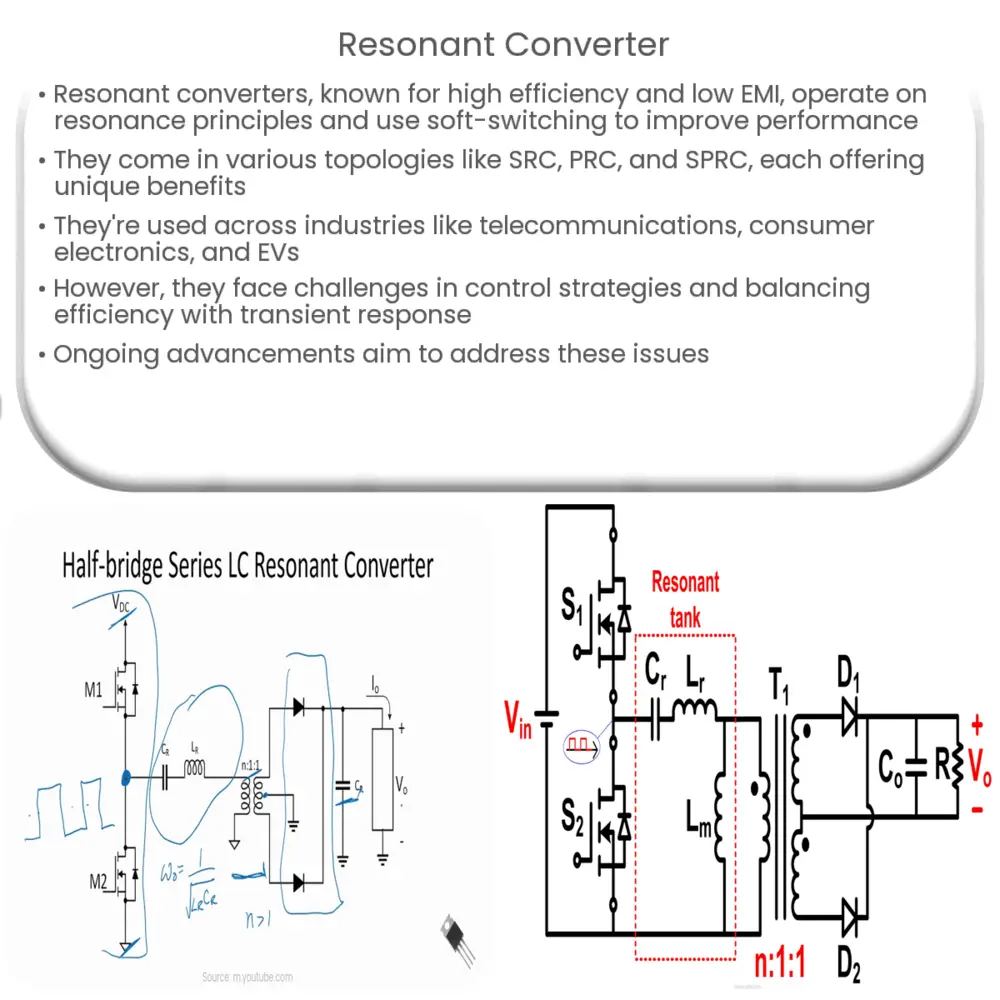Resonant converters are efficient power electronics that leverage resonance for energy transfer, offering compact designs and low EMI in various industries.

Understanding the Resonant Converter: Principles and Applications
Introduction
Resonant converters have emerged as a popular choice in power electronics due to their high efficiency, compact size, and low electromagnetic interference (EMI). These converters leverage the principle of resonance to achieve their unique features and performance capabilities. In this article, we will delve into the fundamental concepts of resonant converters, their various topologies, and applications in different industries.
Principles of Resonant Converters
Resonant converters work on the concept of resonance, a phenomenon where a circuit oscillates at its natural frequency, resulting in the efficient transfer of energy between different components. Resonant converters consist of a resonant tank circuit, which includes a capacitor and an inductor, as well as switches that control the flow of energy. The tank circuit stores and releases energy at a specific frequency, allowing for efficient power conversion.
The key advantage of resonant converters is their ability to achieve soft-switching or zero-voltage switching (ZVS) and zero-current switching (ZCS). Soft-switching reduces the switching losses and stress on the components, resulting in improved efficiency and extended lifetime of the converter. This also leads to a reduction in EMI, making resonant converters ideal for applications with strict EMI requirements.
Types of Resonant Converters
There are several topologies of resonant converters, each with its unique characteristics and applications. Some of the most common types include:
- Series Resonant Converter (SRC): In this topology, the resonant inductor and capacitor are connected in series. The energy transfer occurs when the input voltage is in phase with the tank circuit current. SRCs are widely used due to their simplicity, high efficiency, and ability to achieve ZVS.
- Parallel Resonant Converter (PRC): PRCs have the resonant inductor and capacitor connected in parallel. The energy transfer happens when the input voltage is in phase with the tank circuit voltage. PRCs are known for their high efficiency and ZCS operation but may require more complex control strategies.
- Series-Parallel Resonant Converter (SPRC): This topology combines the features of SRC and PRC, with both series and parallel resonant elements. SPRCs offer a wide range of operation, high efficiency, and the ability to achieve both ZVS and ZCS, making them suitable for various applications.
Applications of Resonant Converters
Resonant converters find their applications in a wide range of industries, including:
- Telecommunications: They are used in power supplies for base stations, wireless communication devices, and optical network equipment, where high efficiency and low EMI are crucial.
- Consumer Electronics: Resonant converters are employed in power adapters, chargers, and power supplies for devices like smartphones, laptops, and televisions.
- Electric Vehicles: These converters are utilized in battery chargers, on-board chargers, and DC-DC converters for electric and hybrid vehicles, providing high efficiency and compact designs.
- Industrial Applications: Resonant converters are used in motor drives, uninterruptible power supplies (UPS), and renewable energy systems, where high efficiency, reliability, and low EMI are essential.
- Medical Equipment: Medical devices like MRI machines, X-ray generators, and patient monitoring systems require power supplies with low EMI, making resonant converters an ideal choice.
Challenges and Future Developments
Despite their numerous advantages, resonant converters also face some challenges. One such challenge is the complexity of control strategies, especially in PRC and SPRC topologies. Developing advanced control algorithms that can adapt to different load conditions and ensure optimal performance is an ongoing area of research.
Another challenge is the trade-off between efficiency and transient response. While resonant converters excel at achieving high efficiency, their transient response can be slower than conventional converters due to the energy storage in the resonant tank circuit. Researchers are exploring ways to improve transient response without compromising efficiency.
With the rapid advancements in power electronics and semiconductor technology, new resonant converter designs and topologies are expected to emerge, further enhancing their performance and expanding their applications. Wide-bandgap devices like Silicon Carbide (SiC) and Gallium Nitride (GaN) have the potential to significantly improve the efficiency, power density, and switching speed of resonant converters.
Conclusion
Resonant converters have become an indispensable part of modern power electronics due to their high efficiency, compact size, and low EMI. With a wide range of applications across various industries, these converters continue to evolve, driven by advancements in control strategies, semiconductor technology, and innovative topologies. As a result, resonant converters are poised to play a critical role in shaping the future of power conversion and energy management in our increasingly connected and electrified world.

